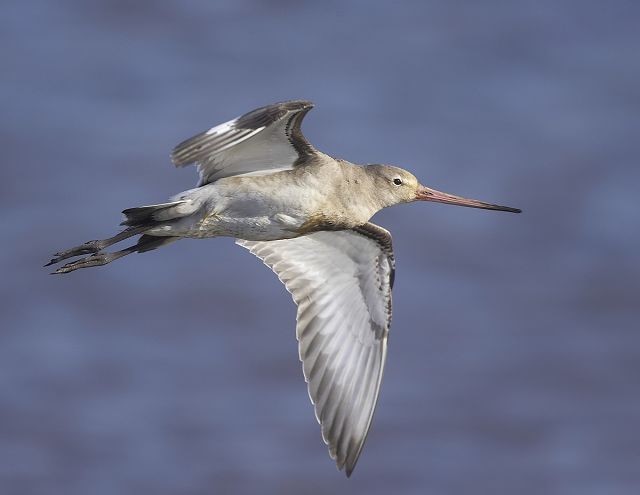
Black-tailed Godwit: Northants, March. (photo: Richard Bedford).
Introduction
For many birdwatchers the godwits are a favourite family of waders. Whether the encounter is with a wintering flock of 'Barwits' on coastal mudflats on a crisp winter's day, or a brief party of glamorous 'Blackwits' bound for Iceland on your inland patch in April, they're always exciting birds to watch.
Bar-tailed Godwits are passage and winter visitors to our shores. The breeding grounds stretch from Norway eastwards to Alaska, where the birds breed on the open tundra. The nominate race occurs in Britain and these birds breed as far east as the Taimyr Peninsula. Birds from Scandinavia and western Siberia winter in western Europe. Those from central Siberia winter in west Africa, and east Siberian birds of the race baurei winter from southeast Asia to Australasia: dark-backed and -rumped birds of this race are potential candidates for vagrancy to Europe. In Britain this species is primarily found on sandy estuaries and intertidal areas, with the largest numbers on The Wash, though birds can be found inland at times, where they are scarce. Although present year-round, numbers are at their largest in December and January and over 60,000 are thought to winter.
The Black-tailed Godwit is, for many, the more appealing of the two species. Breeding only in the Palearctic, the islandica race, which breeds in Iceland, winters mainly on the estuaries of Britain, Ireland and western Europe, whilst two-thirds of the European breeding population, nominate limosa, breeds in The Netherlands and winters in west Africa and Iberia. A third race, melanuroides, breeds in east Siberia and winters from India east to Australia. Birds breeding in Britain use lowland pasture, though the breeding population is small and largely restricted to the Fens. It is as a winter visitor and passage migrant that 'Blackwits' are most obvious and up to 20,000 birds were present on WeBS counts at the turn of the century.
Identification
Identification of both species is usually relatively straightforward, especially in flight, but on the ground separation of lone birds or small groups can be more troublesome. Some key features to look for on non-flying birds include:
- The longer legs of Black-tailed, especially the distance between the 'knee' and the body, which give the species a more elegant appearance - the one with the longer name is the one with the largest gap!
- Black-tailed has a long, mostly straight, bill and appears longer-necked and more elegant.
- Feeding birds can often give clues to their identity. Black-tailed feeds with its head down, frequently swallowing by tipping the head back, and up, a trait not shared with Bar-tailed.
- On Black-tailed the breast and neck are virtually unstreaked and, on juveniles, the more uniformly fringed coverts and scapulars give a neat scaly pattern unlike the streaked upperparts of Bar-tailed.
Summer plumage
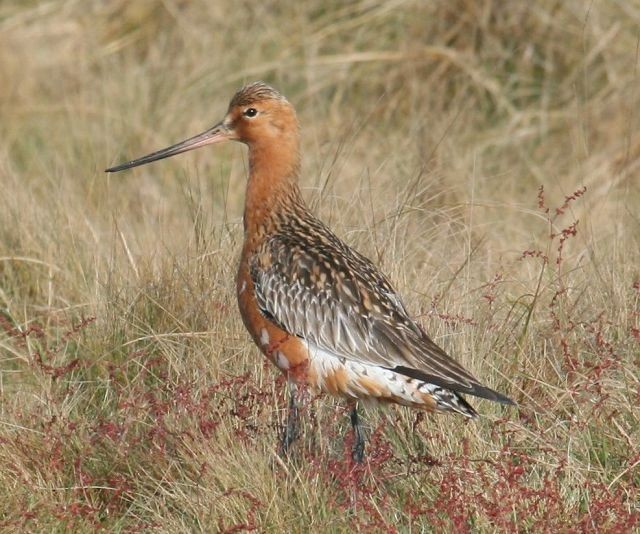
Bar-tailed Godwit: Suffolk, May. In summer plumage the brick-red underparts extend to the undertail coverts on males. This is much more extensive than would be shown by a Black-tailed. Females have paler underparts, lacking the intensity of the males (photo: R. Davis).

Bar-tailed Godwit: Suffolk, April. The legs of Bar-tailed are shorter, especially the distance between the 'knee' and the body. A useful way to remember which species is which is to think of the number of letters in the first part of the name - 'Black' is a longer word and it is this species that has a longer 'tibia' and thus appears more 'leggy'. On summer birds the underparts lack the bars of Black-tailed and the bill is dark (photo: Andrew Easton).

Black-tailed Godwit: Norfolk, April. Clearly longer-legged, with barred underparts and a straight bi-coloured bill with an orange base. Look out also for colour-ringed birds amongst any groups that you see (photo: Chris Cook).

Black-tailed Godwit: Lancs, April. Summer birds have 'scallops' on the belly and a longer bill and legs than Bar-tailed (photo: Sue Tranter).
Non-breeding plumage

Bar-tailed Godwit: Norfolk, September. Unlike Black-tailed in the same plumage Barwits have upperparts that resemble Curlew; note also the streaked neck sides. Juveniles have spotted edges to the scapulars and tertials (photo: Garth Peacock).

Bar-tailed Godwit: Fife, September. The bill is noticeably upcurved, and shorter, than Black-tailed, though bill lengths differ between the sexes with females having a longer, Black-tailed-like bill. Unlike Black-tailed, the supercilium extends backwards well beyond the eye (photo: John Anderson).

Bar-tailed Godwit: Lothian, March. Structurally much more squat than Black-tailed. Habitat can be a rough guide to the species involved: large coastal flocks in winter will most likely involve Bar-tailed, but this rule of thumb should be applied with caution given increasing numbers of wintering Blackwits (photo: Mike Thrower).

Black-tailed Godwit: Norfolk, February. In the winter the plumage is sleeker than that of Barwits, with greyish upperparts, white belly and a short supercilium that just reaches to the eye (photo: Steve Seal).

Black-tailed Godwit: Norfolk, January. Like other waders, juvenile head and body feathers are replaced by first-winter plumage in a moult during the first autumn: first-winter birds can be aged as such until at least mid-winter by the retained juvenile wing-coverts (photo: Peter Simpson).
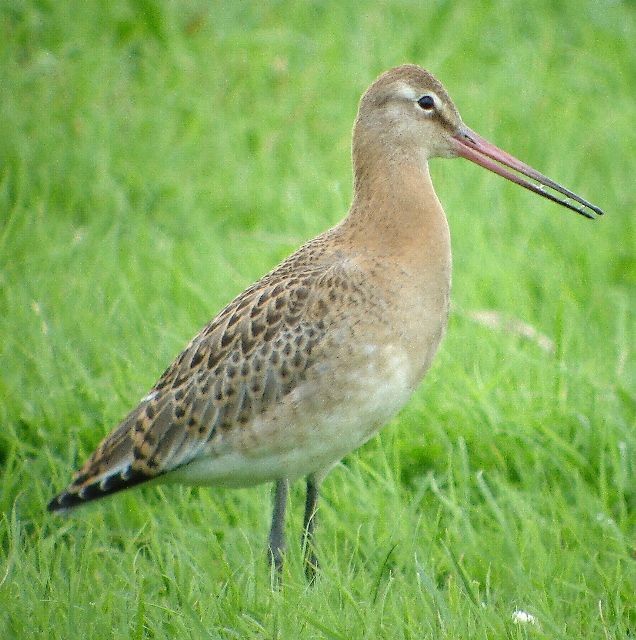
Black-tailed Godwit: Lothian, September. Juveniles have coarsely spotted upperparts and a beautiful buff-orange wash to the head and breast (photo: Mike Thrower).
In flight
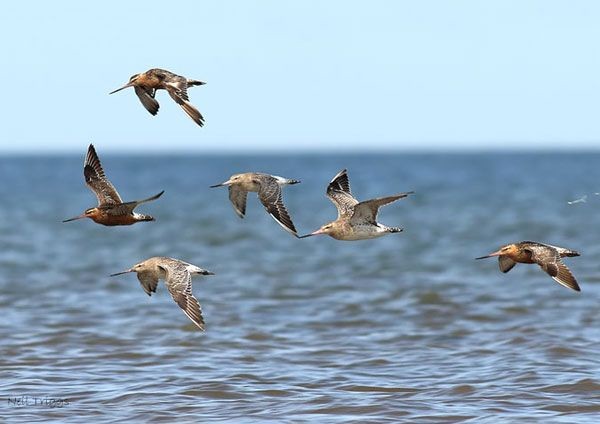
Bar-tailed Godwit: Norfolk, August. A familiar sight for seawatchers during the autumn, when birds pass in a variety of plumages (photo: Neil Triggs).

Bar-tailed Godwit: Norfolk, March. Unlike Black-tailed the feet barely project beyond the tail, creating the impression of a short rear. Distant birds on a seawatch might invite confusion with Whimbrel - unless, of course, they contain a summer-plumaged bird for assistance! (photo: Matt Latham).

Bar-tailed Godwit: Norfolk, December. Markedly different from Black-tailed in flight, with plain upperwing and duller underwing lacking the cleanliness of Black-tailed (photo: Peter Simpson).
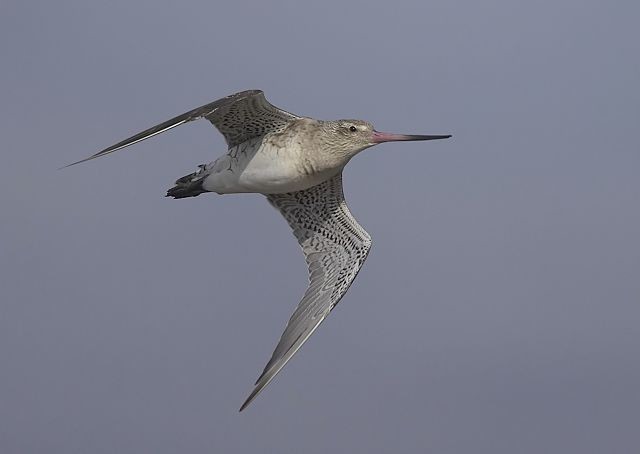
Bar-tailed Godwit: Norfolk, September. The intricate markings on the underwing are less easy to appreciate in the field, where the underwing simply appears 'dullish' (photo: Richard Bedford).

Bar-tailed Godwit: Norfolk, August. With brick red underparts and white 'V' extending up the rump, Barwits are often under-rated (photo: Peter Simpson).

Bar-tailed Godwit: Lincs, May. Here the barred tail is easy to see, as is the extension of the white onto the back (photo: Dean Eades).
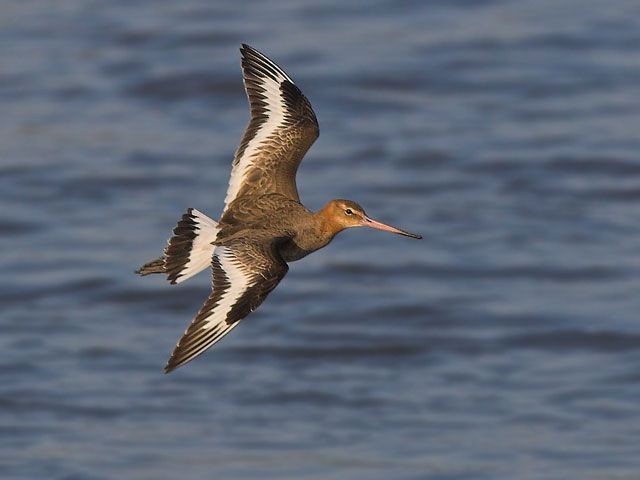
Black-tailed Godwit: Cheshire, April. The striking upperwing, and tail, pattern immediately dispels any confusion over the identity of the godwit in front of you as it takes to the air (photo: Steve Round).

Black-tailed Godwit: Cheshire, July. A flock of these 'stripy' waders makes for a eye-catching sight (photo: Steve Round).

Black-tailed Godwit: Northants, July. On high-flying birds overhead the underwing of Black-tailed is clean, with contrasting black tips to the primaries and secondaries (photo: Richard Bedford).

Black-tailed Godwit: Northants, July. The toes project significantly beyond the tail and this, along with the longer neck and bill, make for a much 'elongated' species in flight (photo: Richard Bedford).
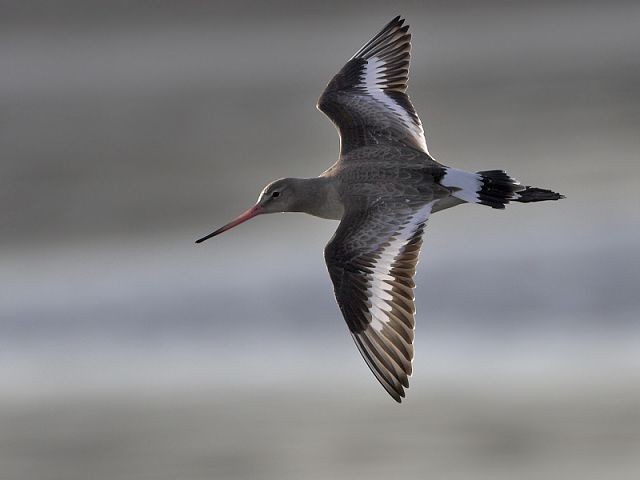
Black-tailed Godwit: Fife, February. A relatively drab species at rest in non-breeding plumage, but a real eye-catcher in flight at any time of the year (photo: John Anderson).
Something a bit rarer?
Hudsonian Godwit is a North American species that has been recorded in Europe on a handful of occasions. The last time was in 1988 in Northeast Scotland and three sightings between 1981 and 1983, in East Yorkshire and Devon, presumably related to the same individual.
Hudsonian appears to posses characteristics of both of the commoner species, being marginally smaller than Black-tailed with a slightly uptilted and more pointed bill. To clinch the identification of this 'mega', though, a good look at the wing pattern is essential. The axilliaries, and most of the underwing coverts, are blackish and both the wing bar, and white band at the base of the tail, are narrower than is found on Black-tailed.

Hudsonian Godwit: Canada, October. Appears to possess characteristics of both of the commoner species, being marginally smaller than Black-tailed with a slightly uptilted and more pointed bill (photo: Mark Dennis).
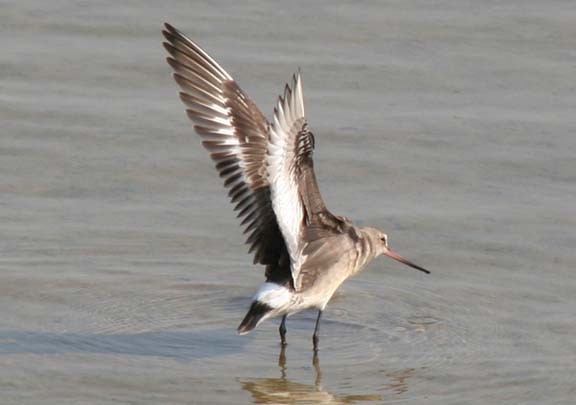
Hudsonian Godwit: Canada, October. The blackish axilliaries, and most of the underwing coverts, are blackish; note also the narrower wing, and tail, band (photo: Mark Dennis).
References
Cramp and Simmons. 2004 Birds of the Western Palearctic interactive. Published by BirdGuides, Sheffield.
Brown and Grice. 2005. Birds in England. Poyser, London.
Svensson, L., Grant, P.J., Mullarney, K., Zetterstrom, D. 1999. Collins Bird Guide. HarperCollins, London.



